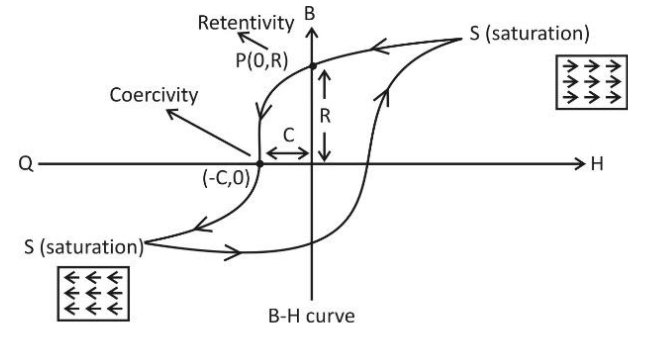
Permanent magnet has properties retentivity and coercivity respectively as:
A. high-high
B. low-low
C. low-high
D. high-low
Answer
532.5k+ views
Hint: A good permanent magnet should produce a high magnetic field with a low mass and should be stable against the influences which would demagnetize it. The desirable properties of such magnets are typically stated in terms of the retentivity (remanence) and coercivity of the magnet materials.
Complete step by step solution:

Retentivity$\left( R \right)$: It is a measure of the remaining magnetization when the driving field$\left( H \right)$is dropped to zero.
Coercivity$\left( C \right)$: It is a measure of the reverse field needed to drive the magnetization into zero after being saturated.
The materials suitable for permanent magnets must have high retentive, high coercivity and high permeability.
Hence the correct option is (A).
Note: The material used for permanent magnet must be high retentively so that magnet be strong and that of high coercively so that the magnetism does not unify out on applying strong magnetic field through it.
Complete step by step solution:

Retentivity$\left( R \right)$: It is a measure of the remaining magnetization when the driving field$\left( H \right)$is dropped to zero.
Coercivity$\left( C \right)$: It is a measure of the reverse field needed to drive the magnetization into zero after being saturated.
The materials suitable for permanent magnets must have high retentive, high coercivity and high permeability.
Hence the correct option is (A).
Note: The material used for permanent magnet must be high retentively so that magnet be strong and that of high coercively so that the magnetism does not unify out on applying strong magnetic field through it.
Recently Updated Pages
CBSE Class 2 English Sample Paper Set 6 (2025-26) Free PDF

CBSE Class 1 Maths Sample Paper 2025-26 (Mock Paper 7) FREE PDF

Full Form: Updated List (2025) of Important Abbreviations You Should Know

MD Full Form: Meaning, Uses & Comparison (2025 Guide)

MCB Full Form: Meaning, Definition & Applications Explained

CBSE Class 1 Hindi Sample Paper 2025-26 (Set 7) Mock Test

Trending doubts
1 ton equals to A 100 kg B 1000 kg C 10 kg D 10000 class 11 physics CBSE

Difference Between Prokaryotic Cells and Eukaryotic Cells

One Metric ton is equal to kg A 10000 B 1000 C 100 class 11 physics CBSE

1 Quintal is equal to a 110 kg b 10 kg c 100kg d 1000 class 11 physics CBSE

Proton was discovered by A Thomson B Rutherford C Chadwick class 11 chemistry CBSE

Draw a diagram of nephron and explain its structur class 11 biology CBSE




